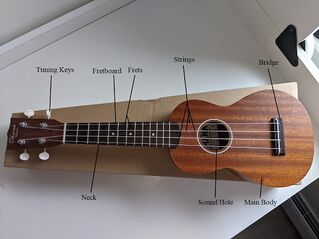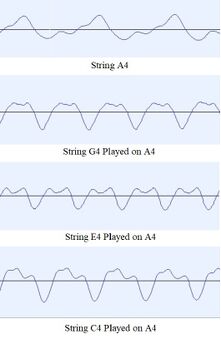Courses:PHYS341/2021/Project15
Ukulele
History of the Ukulele
The ukulele is a small, guitar-like, stringed instrument that generally uses 4 nylon strings as opposed to the typical 6 strings in guitar. Sound is produced by strumming and plucking the strings. It is known today as an Hawaiian instrument but the ukulele is actually an adaptation of a similar Portuguese instrument from Europe. In around the late 19th century, around the 1880s, Portuguese cabinet makers from Madeira immigrated to Hawaii and brought with them an instrument called the “machete”, a small guitar with 4 strings. Three particular cabinet makers named Manuel Nunes, José do Espírito Santo, and Augusto Dias who had now moved to Honolulu in Hawaii began including stringed instruments in their craft and trade and began to produce these machetes. They are known to be initial inventors of these instruments. These machetes would then come to be known to the Hawaiians as “taro patch fiddle” but there is no known concrete evidence of how the term “ukulele” came about to officially refer to the small instrument. Roughly translated to “jumping flea”, the name describes the player’s quick movement of their fingers on the strings and fretboard. Over time the ukulele has been promoted and accepted to be associated with Hawaiian culture and its popularity has spread, particularly in Western music and culture. [1]

Construction of a Ukulele
The design of a ukulele consists of several parts. A ukulele has a short neck where the fretboard is placed, four strings, tuning keys for the strings, a bridge, and a main body shaped like a figure 8 reminiscent of the main body of a guitar. There is also a sound hole on the main body. The 4 strings are tuned to the notes G-C-E-A. This tuning is known as the “standard tuning”
The main body of a ukulele is typically made from wood, but plastic instruments have also been made and sold. Different woods can be used to construct the body, some of which include maple wood, walnut wood, elm wood, and Hawaiian koa wood. It should be noted that the type of wood used can impact the ukulele’s sound, tone, and quality which is why selecting the wood first in the ukulele-making process is important because it can affect the sound quality of the finished product as well as its appearance. Known as the best wood for ukuleles, some manufacturers use Mahogany to create their ukuleles because it is known as a “soft” hardwood that creates warm and mellow tones and progressively sounds better as the instrument ages. The rest of the ukulele’s parts tend to also be made from the same wood as the main body. For the strings, ukuleles tend to have nylon strings although some manufacturers produce ukuleles with steel strings instead.

In the other parts of the ukulele construction process, the wood chosen for the ukulele is treated with a lacquer coating to preserve and protect the instrument and to add a final smooth touch to its appearance. Glue and adhesives are also used to piece some parts of the ukulele together. [2]
Types of Ukuleles
There are four commonly known types of ukuleles, aptly named for the sound quality it produces: soprano, concert (also known as alto), tenor, and baritone. [3][4]
- The soprano ukulele is considered the most common and standard type of ukulele and is the smallest of the four. It also has the least amount of frets due to a relatively short neck size. This soprano size produces a thinner sound than the other sizes.
- The concert ukulele has a slightly bigger body than the soprano and thus produces a much more rounded and fuller sound. This ukulele is also longer and thus will have more tension on the strings and the frets are more spaced out, allowing a performer to play higher notes.
- The tenor ukulele is slightly bigger than the concert ukulele and has an even richer and fuller sound than the last two sizes. It’s neck is also longer so the performer has more frets to reach even higher notes.
- The biggest size is the baritone ukulele and thus produces the deepest sound out of the ukuleles. It also has the longest neck and amount of frets on the fretboard. This size is also the only one where the tuning is different and lower because tuning it up to the standard of G-C-E-A will lose the bright quality of the smaller ukulele sizes due to its larger body and fuller sound.
To explain how a ukulele’s body size correlates to different sound qualities: a smaller main body will have higher resonances and produce higher frequencies and the bigger the ukulele’s main body, the progressively lower the resonance and frequencies produced. The string used (steel versus nylon) will also affect the sound because nylon strings are lighter in mass and would produce a higher frequency.

Exploring The Harmonic Series and Timbre of Ukulele Strings

The standard tuning of this right-handed mahogany soprano ukulele from top to bottom is tuned as G4, C4 (also known as middle C), E4, and A4 on nylon strings. The thickness of strings A4 and G4 are the same meaning that string A4 is pulled more tightly by its tuning key to produce a note higher than the G4 string when plucked. The E4 string is slightly thicker and thus has a heavier mass, producing a lower note and pitch when plucked. Similarly, string C4 is the thickest of the string and produces the lowest note and pitch when plucked.
String G4, E4, and C4 all can be manipulated to produce the same note A4 by placing down a finger on the 2nd fret, 5th fret, and 9th fret respectively. However, when each string is plucked, the sound quality of the A4 note is noticeably different from the actual A4 string.
It is interesting to note that the thicker the string is and the more loosely it is tightened compared to the A4 string, the farther down the fretboard one would need to hold a string down in order to produce the higher note A4. This is because by progressively holding a finger down the fretboard, the length of string vibrating as its plucked becomes shorter. This decreases the wavelength of the string and increases the frequency of the sound, thus producing a higher pitch.
As can be seen in Figure 3 and 4, the soundwaves were taken from the highest air displacement from the equilibrium where the sound was at its loudest. Examining the shapes of the soundwaves for each string, it can be seen that the timbres are significantly different. This accounts for the several different sound qualities that can be heard when each string was plucked to produce note A4.
What accounts for the different shapes and different timbres of the soundwaves for each string is the differing harmonic content. In Figure 5 below we can see the different harmonic frequencies present from each sound wave. While the fundamental frequency is the same for all strings, the differing sound quality comes from the harmonics above it. In the figure for each string, different harmonics are being emphasized while others are more dampened. For strings A4 and G4, the sound quality sounded brighter and more tinny due to the fact that the strings were thinnest and the tighter pull from the tuning keys. This is reflected in their harmonics series where we can see that fundamental frequency seems to dominate and there are less harmonics being emphasized. However, the sound quality of strings E4 and C4 is more fuller-sounding and darker due to the strings being thicker in diameter. In their harmonic series we can see that there are a lot of harmonics being emphasized more than in the harmonic series of the previous two strings.

Thus, plucking each string on the ukulele for the same note will produce different harmonic content. This difference also leads to a difference in the shape of the soundwave and thus a difference in the timbre and sound quality you would hear despite the fact that it’s the same note that can be heard from the same instrument.
References
- https://web.archive.org/web/20040803005054/http://www.ukuleleguild.org/history.php
- http://www.madehow.com/Volume-6/Ukulele.html#:~:text=Design,concert%2C%20tenor%2C%20and%20baritone.
- https://ukuleletricks.com/ukulele-sizes-soprano-concert-tenor-baritone/
- https://www.ukuleles.com/Technology/sounds.html